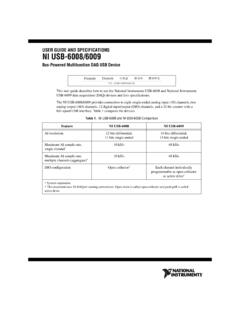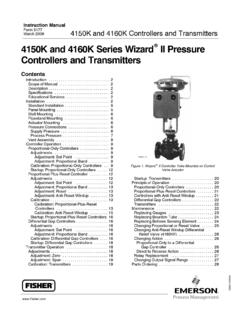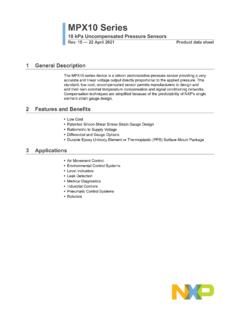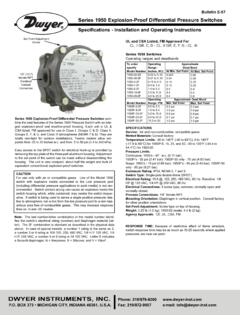Transcription of Chapter 3: Fluid Statics - University of Iowa
1 57:020 Fluid Mechanics Chapter 2 Professor Fred Stern Fall 2013 1 Chapter 2: pressure and Fluid Statics pressure For a static Fluid , the only stress is the normal stress since by definition a Fluid subjected to a shear stress must deform and undergo motion. Normal stresses are referred to as pressure p. For the general case, the stress on a Fluid element or at a point is a tensor For a static Fluid , ij = 0 i j shear stresses = 0 ii = p = xx = yy = zz i = j normal stresses =-p Also shows that p is isotropic, one value at a point which is independent of direction, a scalar.
2 *Tensor: A mathematical object analogus to but more general than a vector, represented by an array of components that are functions of the coordinates of a space (Oxford) ij = stress tensor* = xx xy xz yx yy yz zx zy zz i = face j = direction 57:020 Fluid Mechanics Chapter 2 Professor Fred Stern Fall 2013 2 x z Definition of pressure : A0 FdFpAdAlim N/m2 = Pa (Pascal) F = normal force acting over A As already noted, p is a scalar, which can be easily demonstrated by considering the equilibrium of forces on a wedge-shaped Fluid element Geometry A = y x = cos z = sin Fx = 0 pn A sin - px A sin = 0 pn = px Fz = 0 -pn A cos + pz A cos - W = 0 y)sin)(cos(2W 0sincos2coscos2 yypypzn W = mg = Vg = V V = x z y 57.
3 020 Fluid Mechanics Chapter 2 Professor Fred Stern Fall 2013 3 ppnz 20 sin ppfornz 0 , pn = px = py = pz p is single valued at a point and independent of direction. A body/surface in contact with a static Fluid experiences a force due to p BSpdAnpF Note: if p = constant, Fp = 0 for a closed body. Scalar form of Green's Theorem: sf ndsfd f = constant f = 0 57:020 Fluid Mechanics Chapter 2 Professor Fred Stern Fall 2013 4 pressure Transmission Pascal's law: in a closed system, a pressure change produced at one point in the system is transmitted throughout the entire system.
4 Absolute pressure , Gage pressure , and Vacuum For pA>pa, pg = pA pa = gage pressure For pA<pa, pvac = -pg = pa pA = vacuum pressure pA < pa pg < 0 pg > 0 pA > pa pa = atmospheric pressure = kPa pA = 0 = absolute zero 57:020 Fluid Mechanics Chapter 2 Professor Fred Stern Fall 2013 5 pressure Variation with Elevation Basic differential Equation For a static Fluid , pressure varies only with elevation within the Fluid . This can be shown by consideration of equilibrium of forces on a Fluid element Newton's law (momentum principle) applied to a static Fluid F = ma = 0 for a static Fluid , Fx = Fy = Fz = 0 Fz = 0 pdxdyppzdzdxdygdxdydz () 0 pzg Basic equation for pressure variation with elevation 1st order Taylor series estimate for pressure variation over dz 57.
5 020 Fluid Mechanics Chapter 2 Professor Fred Stern Fall 2013 6 0yp0dxdz)dyypp(pdxdz0Fy 0xp0dydz)dxxpp(pdydz0Fx For a static Fluid , the pressure only varies with elevation z and is constant in horizontal xy planes. The basic equation for pressure variation with elevation can be integrated depending on whether = constant or = (z), , whether the Fluid is incompressible (liquid or low-speed gas) or compressible (high-speed gas) since g constant pressure Variation for a Uniform-Density Fluid pzg pz 2121ppzz Alternate forms: 1122pzpz pz p z 00 , pz = constant for liquid constant constant piezometric pressure gage constant piezometric head pz increase linearly with depth decrease linearly with height Z pz g 57.
6 020 Fluid Mechanics Chapter 2 Professor Fred Stern Fall 2013 7 112221121atm2oil32water23pzcons tan tpzpzppzzpp0pz .8 9810 .9 9810 57:020 Fluid Mechanics Chapter 2 Professor Fred Stern Fall 2013 8 pressure Variation for Compressible Fluids: Basic equation for pressure variation with elevation ( , )dpp zgdz pressure variation equation can be integrated for (p,z) known. For example, here we solve for the pressure in the atmosphere assuming (p,T) given from ideal gas law, T(z) known, and g g(z).
7 P = RT R = gas constant = 287 J/kg K p,T in absolute scale RTpgdzdp )z(TdzRgpdp which can be integrated for T(z) known dry air 57:020 Fluid Mechanics Chapter 2 Professor Fred Stern Fall 2013 9 zo = earth surface = 0 po = kPa T = 15 C = K/km pressure Variation in the Troposphere T = To (z zo) linear decrease To = T(zo) where p = po(zo) known = lapse rate = K/km )]zz(T[dzRgpdpoo dz'dz)zz(T'zoo constant)]zz(Tln[Rgplnoo use reference condition constantTlnRgplnoo solve for constant RgooooooooT)zz(TppT)zz(TlnRgppln , p decreases for increasing z 57.
8 020 Fluid Mechanics Chapter 2 Professor Fred Stern Fall 2013 10 pressure Variation in the Stratosphere T = Ts = 55 C dppgRdzTs constantzRTgplns use reference condition to find constant ]RT/g)zz(exp[ppeppsooRT/g)zz(os0 , p decreases exponentially for increasing z. 57:020 Fluid Mechanics Chapter 2 Professor Fred Stern Fall 2013 11 pressure Measurements pressure is an important variable in Fluid mechanics and many instruments have been devised for its measurement. Many devices are based on hydrostatics such as barometers and manometers, , determine pressure through measurement of a column (or columns) of a liquid using the pressure variation with elevation equation for an incompressible Fluid .
9 More modern devices include Bourdon-Tube Gage (mechanical device based on deflection of a spring) and pressure transducers (based on deflection of a flexible diaphragm/membrane). The deflection can be monitored by a strain gage such that voltage output is p across diaphragm, which enables electronic data acquisition with computers. In this course we will use both manometers and pressure transducers in EFD labs 2 and 3. differential manometer Bourdon-Tube Gage 57:020 Fluid Mechanics Chapter 2 Professor Fred Stern Fall 2013 12 Manometry 1. Barometer pv + Hgh = patm Hg = kN/m3 patm = Hgh pv 0 , vapor pressure Hg nearly zero at normal T h 76 cm patm 101 kPa (or psia) Note: patm is relative to absolute zero, , absolute pressure .
10 Patm = patm(location, weather) Consider why water barometer is impractical OHOHHgHg22hh H2O = kN/m3 . 57:020 Fluid Mechanics Chapter 2 Professor Fred Stern Fall 2013 13 patm 2. Piezometer patm + h = ppipe = p absolute p = h gage Simple but impractical for large p and vacuum pressures ( , pabs < patm). Also for small p and small d, due to large surface tension effects, which could be corrected using h 4d , but accuracy may be problem if p/ h. 3. U-tube or differential manometer p1 + m h l = p4 p1 = patm p4 = m h l gage = w[Sm h S l] for gases S << Sm and can be neglected, , can neglect p in gas compared to p in liquid in determining p4 = ppipe.
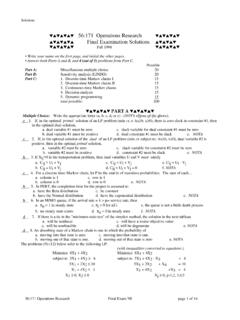
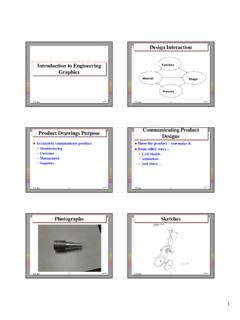
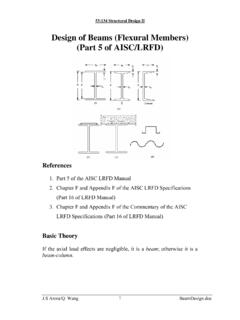
![Corrosion Protection.ppt [Read-Only] - University of Iowa](/cache/preview/1/c/f/9/2/e/d/5/thumb-1cf92ed5cf903dbf2b6cd3a840081a01.jpg)


